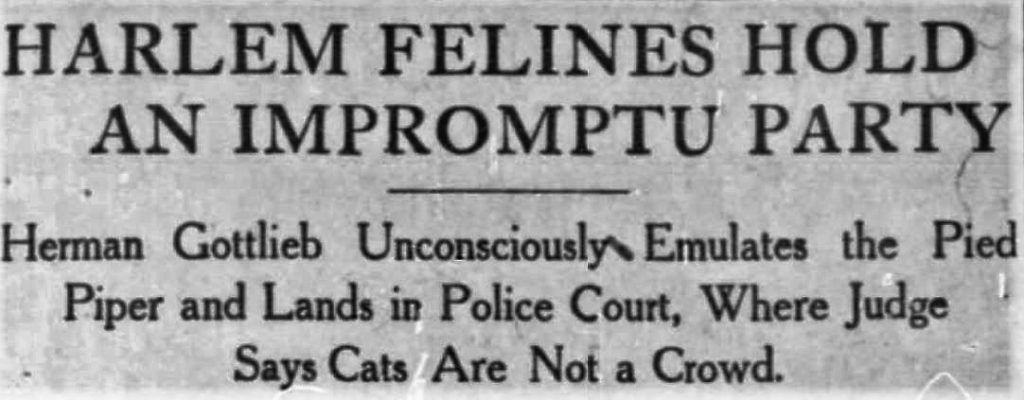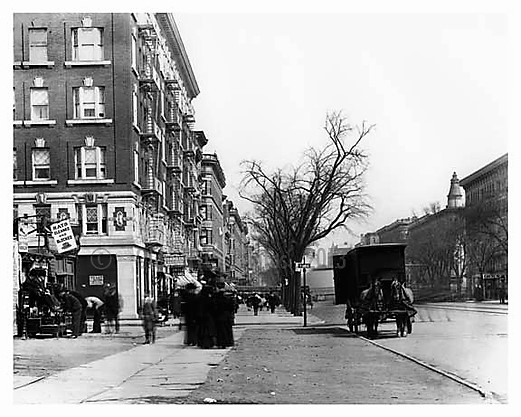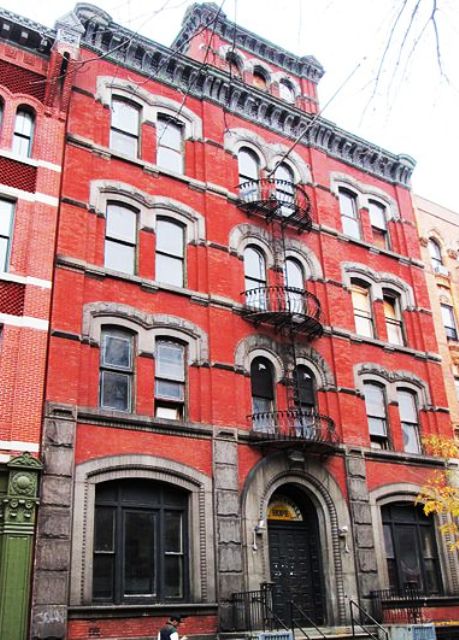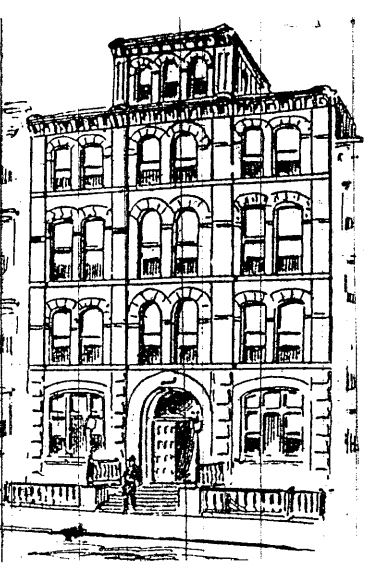
This headline about the great catnip caper appeared in the Washington Times on August 19, 1909. The story made the headlines in more than 20 large newspapers across the country.
East Harlem merchant G. Herman Gottlieb had a little knowledge of botany and a great desire to make some quick cash. So he left his home at 188 East 99th Street with two empty baskets and made his way to the wooded area on Dyckman Street in the Inwood section of Manhattan. There, he worked all day long filling his baskets with catnip.
He then took the subway to Lenox Avenue and 110th Street, and began going house to house on Fifth Avenue to sell the catnip to well-to-do families with spoiled pet cats. There was at the time many unemployed, homeless cats who also lived in this neighborhood, and like most cats I know, they simply could not resist the lure of the feline drug of choice. When a few leaves of catnip fell from the baskets, several cats began rolling in them on the ground.
Try as he might, Mr. Gottlieb could not shoo the cats away. In fact, despite his efforts, even more cats began to circle around him, rub against his legs, and plead by mewing and purring. In no time at all, about 30 or 40 cats were following the Pied Piper of catnip.

Herman Gottlieb took the IRT subway to the station at Lenox Avenue and 110th Street, which is pictured here in April 1901 when the station was first under construction. NYPL Digital Collections

Here’s what Lenox Avenue and 110th Street looked like just eight years later in 1909 when Herman Gottlieb got off the train with his baskets of catnip. NYPL Digital Collections
As the New York Herald reported on August 19, 1909:
“Shame faced felines whose permanent addresses were alleys and backyards, came stealthily forth. All of them, rich and poor, aristocrats from the sofa cushions near the front windows and thin piebelans from the areaways struggled mightily to get into the two baskets of catnip.”
When Mr. Gottlieb saw Police Sergeant John F. Higgins on 114th Street, he cried out with joy. At last, he thought, someone could help him disperse the band of felines. Sergeant Higgins wasn’t so kind though, and he immediately arrested the catnip peddler for causing a crowd to collect, which was against the law.
“Why don’t you arrest the catnip?” Gottlieb asked. “That is collecting the crowd. Not I.”
“Come on, before the cats from the Bronx and Jersey get here,” Higgins said, leading Gottlieb to the station house on East 104th Street. Several cats followed the men to the station house and made themselves at home inside while Sergeant Higgins reported the arrest to Lieutenant Lasky.

Sergeant Higgins led Mr. Gottlieb and his crowd of cats to the 39th Police Precinct Station House at 177-179 East 104th Street. Here, the men and cats were met by station house cat Pete, who did not take too kindly to the high-on-catnip stray cats.
“We can’t hold this man,” Lieutenant Lasky said. “The law says a man must not cause a crowd of people to collect. The law doesn’t say anything about cats.”
“The law doesn’t say anything about people,” Higgins replied. “It says a ‘crowd.’ A crowd of cats is certainly a crowd.”
As the men argued over how to interpret the vague law, Pete, one of the two station house cats, thrashed at the feline intruders one at a time (Claude, the other station cat, must have been asleep on the job). He was doing a pretty good of clearing out the place when the policemen came to his aid and drove the last cat-fight survivors out onto the steps.
Gottlieb, still holding his baskets of catnip, was placed in a patrol wagon and driven home. The cats tried to keep up with the horse-drawn wagon, but although they proved to be fair sprinters, they could not qualify as long-distance runners.
Gottlieb got out of the wagon, and, hugging his baskets, ran for his catless home. At his heels was a frayed old black cat, the only survivor of the catnip caper.
Gottleib threw him a handful of catnip. “Don’t tell your relatives or your friends,” he warned as he slammed his door shut.
A Brief History of the Old 39th Police Precinct Station House
The 39th Precinct of East Harlem was established in 1863 as the 23rd Precinct, with headquarters at 432-434 East 88th Street (which it shared with the former First Mounted Squad). The station at this location was under the command of Captain John Sanders, an army veteran who was awarded for saving seven persons, including two little girls, from drowning in the East River.
During this time, its jurisdiction was bounded by East 79th and East 110th Street, from Fifth Avenue to the East River. As author Augustine E. Costello noted in his book “Our Police Protectors,” (published in 1885), the 23rd Precinct was a “precinct of long and dreary posts,” with 15 day posts and 39 night posts.
Although construction was starting to pick up in the late 1800s, much of the land in this part of Manhattan was still undeveloped. As Costello wrote of the 23rd Precinct in 1885:
“This district has an Italian colony, of which it is not very proud, House of the Good Shepherd, a shanty district, the repair shops of the Third Avenue Elevated Railroad, a neat little park opposite the Blackwell’s Island lighthouse, and some elegant villas near by, the Astoria Ferry, the boat ferry to Blackwell’s Island, and some mansions of stately magnificence on Fifth Avenue, opposite [Central Park]. There are also the Harlem Flats, with the Harlem Gas Works, and the stables of the Second Avenue Railroad Company.”

Sketch of the new 28th Police Precinct House on East 104th Street, New York Daily Tribune, April 5, 1893. The first floor had an office with the sergeant’s desk, the captain’s rooms, and sitting rooms. The second through fourth floors had sergeants’ rooms and dormitories for the men.
The precinct was renumbered the 27th in 1887, but that designation didn’t last long. As the East Harlem district became more populated and developed in the late 19th century, a new precinct — the 28th — and a new station house a little farther north was needed.
In 1890, the Police Department’s Annual Report noted that negotiations had begun on two vacant lots on East 104th Street for a station house for a new precinct to be made up from portions of the 27th and 29th Precincts. The lot adjacent at #175 was then occupied by Engine Company No. 53 of the New York Fire Department.
Architect to the New York City Police Department, Nathanial D. Bush, filed an application in April 1892 for a five-story station house expected to cost $52,000, as well as for a two-story brick prison and lodging house at the rear to cost $8,000. Construction began in May 1892 and was completed in June 1893.
Captain Josiah A. Westervelt of the City Hall Police was placed in charge of the new 28th Precinct. The new precinct was bounded by 96th Street, 116th Street, Fifth Avenue, and the East River.
After consolidation took place in May 1898, all the police precincts in the city were renumbered. The 28th became the 29th until 1908, when it was renumbered the 39th. It was renumbered the 13th in 1924, and the 23rd in 1929.
The station house served the precinct until a combined facility for the police department and fire department opened in 1974 at 164 East 102nd Street. The old station house was home to Hope Community Hall, a nonprofit housing organization founded in 1868. The building was purchased by the organization at auction in 1981, which occupied the building until moving across the street to #174 in 1994.
The old station house was designated a New York City Landmark in February 1999.

The station house for Engine Company 53, a four-story Queen Anne and Romanesque Revival-style building constructed in 1885, was one of 42 firehouses and related structures designed for the New York Fire Department by the prominent architectural firm of Napoleon LeBrun & Sons between 1879 and 1895. Engine Company 53 was used as a fire station until 1974, and is now owned by Manhattan Community Access Corporation, a local cable television station. To the right was the police station.
If you enjoyed this story, you may also enjoy the tale of superhero policeman Daniel J. Fogarty and the crime-stopping goats, which also took place in the old 39th Police Precinct of East Harlem.



[…] In 1909 a peddler was arrested for causing a crowd to collect. As the peddler was selling catnip, the crowd was a crowd of cats that were following him.. Ref: hatchingcatnyc.com/2017/10/02/catnip-caper-east-harlem/ […]
[…] the history blog The Hatching Cat recounts, what Gottlieb didn’t know was that the neighborhood was also home to plenty of feral […]
[…] The Great Catnip Caper Of 1909 […]